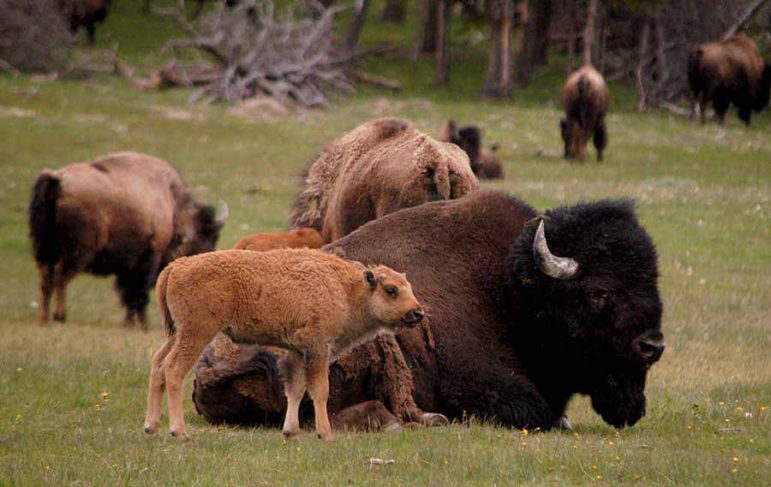
A group of bison graze and rest near the roadside south of Madison in Yellowstone National Park.
CODY, WYO. — Wildlife managers in Yellowstone National Park and their partners in a multi-agency group plan to remove or kill up to 900 bison from the park’s herds of 4,900 animals. Bison will be hunted and captured for slaughter under the plan, which aims to offset increases in Yellowstone’s growing population.
Members of the Interagency Bison Management Plan have signed a winter operations plan that calls for culling 600-900 animals over the next few months. This will be done through public and tribal hunting outside the park and capturing bison near the park boundary for transfer to Native American tribes for processing and distribution of meat and hides to their members.
The plan is the result of several years of ongoing disagreements over how best to manage Yellowstone’s bison, which typically leave the park’s higher elevations during winter in search of better grazing in the region around Gardiner, Mont., near the park’s northern boundary.
Bison advocates say the animals should be able to roam freely, just like elk and other wildlife that seasonally migrate in and out of the park. Cattle ranchers say bison can transmit brucellosis, a disease also carried by elk, that can threaten domestic cattle herds. Bison also can pose a threat to human safety and damage property when moving through populated areas.
“Many people are uncomfortable with the practice of culling bison, including the National Park Service,” Yellowstone Superintendent Dan Wenk said in a statement released by the park’s public affairs office.
“The park would gladly reduce the frequency and magnitude of these operations if migrating bison had access to more habitat outside the park, or there was a way to transfer live bison elsewhere,” Wenk said.
State and federal laws prohibit moving wild bison exposed to brucellosis except to approved meat processing or research facilities. Park officials say they are studying the feasibility of developing quarantine facilities for bison, which would allow animals that repeatedly test negative for brucellosis to be sent alive to other public, private or tribal lands for conservation, hunting or food production.
Hunting is prohibited in Yellowstone, but bison may be hunted once they leave the park. State wildlife managers routinely work to manage the animals’ movements outside the park to avoid conflicts on private lands.
Capturing, slaughtering and hazing bison are inappropriate management techniques, said Stephany Seay, a spokeswoman for the Buffalo Field Campaign. The Montana group monitors bison migrations and management efforts, and advocates for their unfettered movement across the landscape.
“We always oppose capture for slaughter,” Seay said. “There may come a point when wild bison are spread across Montana in recovered numbers that hunting could be used as a management tool. And we support treat rights, but it’s far too soon to be taking from buffalo and not giving back.”
Seay said Yellowstone could support thousands more bison than wildlife managers’ target total herd size of approximately 3,500.
Elk can transmit brucellosis, but are allowed to move freely because of their popularity as big game, Seay said, in contrast with how she said bison are restricted, slaughtered and managed to avoid conflict with cattle.
Seay and other wildlife advocates have praised a recent decision by Montana Gov. Steve Bullock to allow a limited number of Yellowstone bison year-round access to some public lands north of the park, a move that must be formally approved by the IBMP, which is likely later this year.
Millions of bison once roamed the American West, but the animal was almost driven to extinction by hunting, the fur trade, ranching and the wholesale slaughter of bison—including as a strategy for pressuring tribes that relied on the animals.
At one point, fewer than 30 remained, taking refuge in Yellowstone, where they have since flourished. The peak population estimate of 5,000 bison was recorded in the summer of 2005. There are approximately 3,500 bison in the Northern herd and 1,400 in the Central herd, with more than 700 born in a typical year.
Contact Ruffin Prevost at 307-213-9818 or ruffin@yellowstonegate.com.
